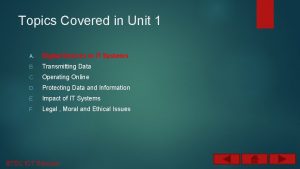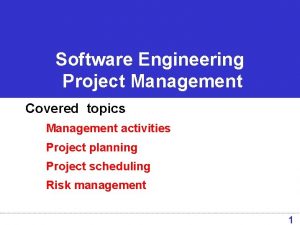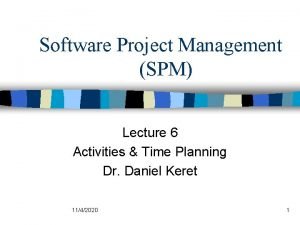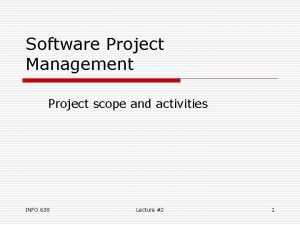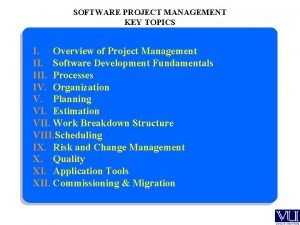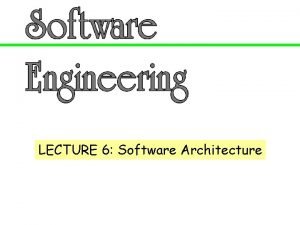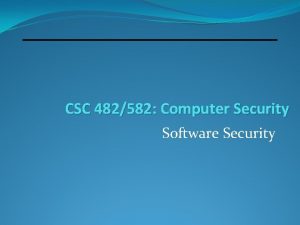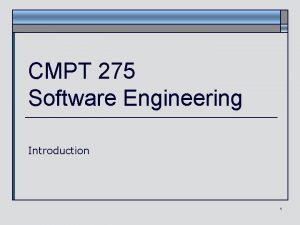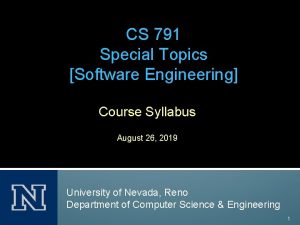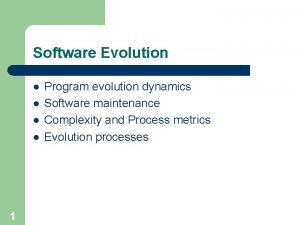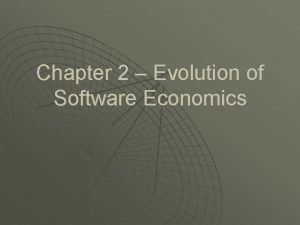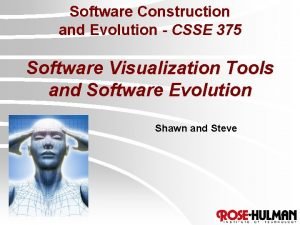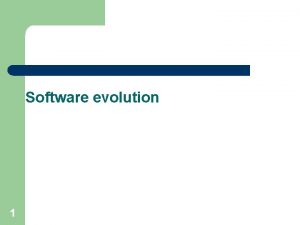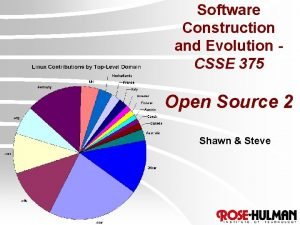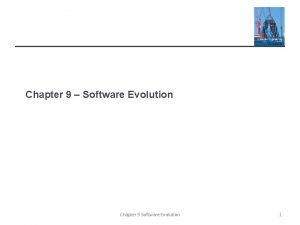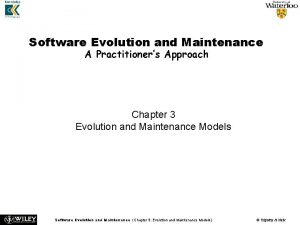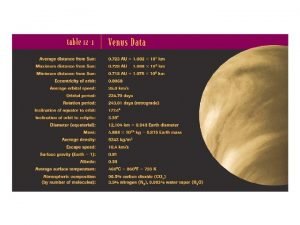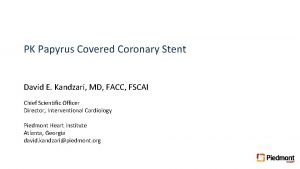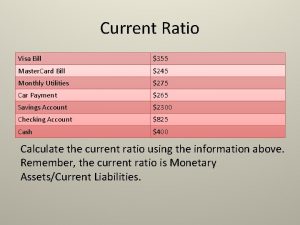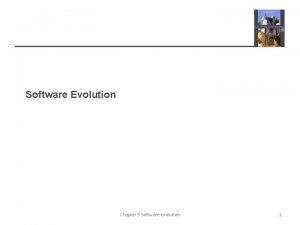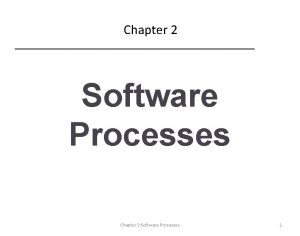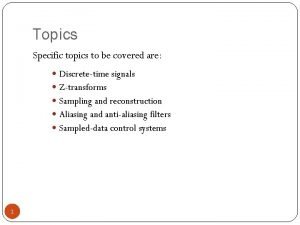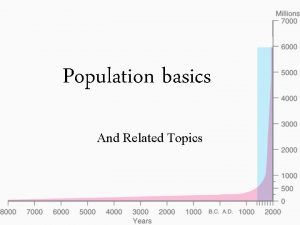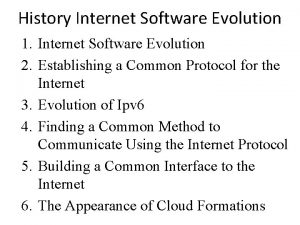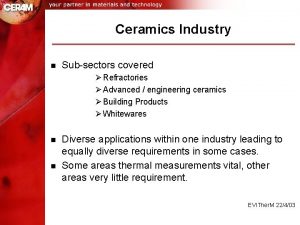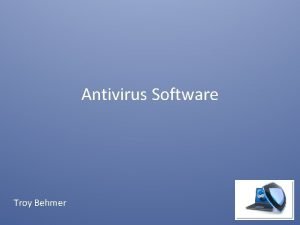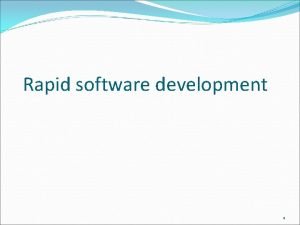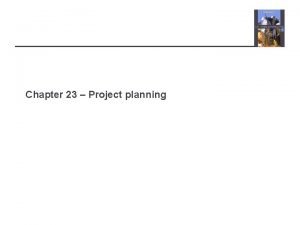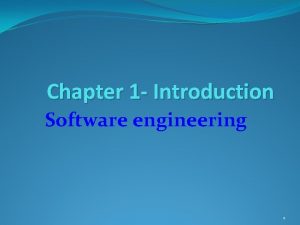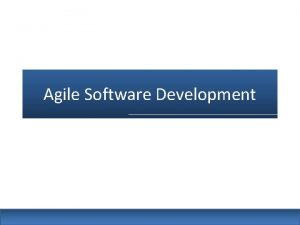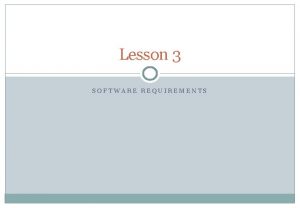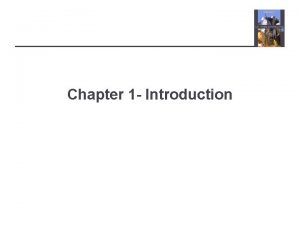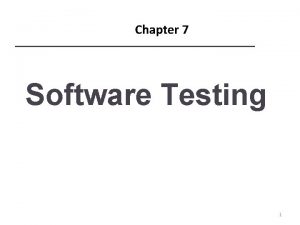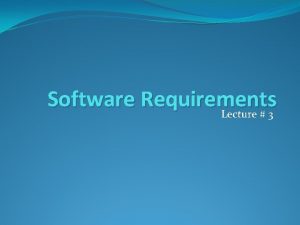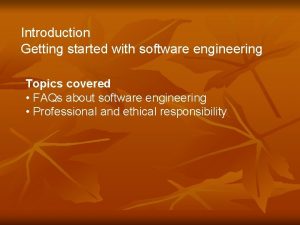Software evolution 1 Topics covered l l 2









































- Slides: 41

Software evolution 1

Topics covered l l 2 Program evolution dynamics Software maintenance Evolution processes Legacy system evolution

Software change l Software change is inevitable – – – l 3 New requirements emerge when the software is used; The business environment changes; Errors must be repaired; New computers and equipment is added to the system; The performance or reliability of the system may have to be improved. A key problem for organisations is implementing and managing change to their existing software systems.

Importance of evolution l l l 4 Organisations have huge investments in their software systems - they are critical business assets. To maintain the value of these assets to the business, they must be changed and updated. The majority of the software budget in large companies is devoted to evolving existing software rather than developing new software.

Spiral model of evolution 5

Program evolution dynamics l l l 6 Program evolution dynamics is the study of the processes of system change. Lehman and Belady proposed that there were a number of ‘laws’ which applied to all systems as they evolved. There are sensible observations rather than laws. They are applicable to large systems developed by large organisations. Less applicable in other cases.

Lehman’s laws 7

Software maintenance l l l 8 Modifying a program after it has been put into use. Maintenance does not normally involve major changes to the system’s architecture. Changes are implemented by modifying existing components and adding new components to the system.

Maintenance is inevitable l l l 9 The system requirements are likely to change while the system is being developed because the environment is changing. Therefore a delivered system won't meet its requirements! Systems are tightly coupled with their environment. When a system is installed in an environment it changes that environment and therefore changes the system requirements. Systems MUST be maintained therefore if they are to remain useful in an environment.

Types of maintenance l Maintenance to repair software faults – l Maintenance to adapt software to a different operating environment – l 10 Changing a system to correct deficiencies in the way meets its requirements. Changing a system so that it operates in a different environment (computer, OS, etc. ) from its initial implementation. Maintenance to add to or modify the system’s functionality – Modifying the system to satisfy new requirements.

Distribution of maintenance effort 11

Maintenance costs l l 12 Usually greater than development costs (2* to 100* depending on the application). Affected by both technical and non-technical factors. Increases as software is maintained. Maintenance corrupts the software structure so makes further maintenance more difficult. Ageing software can have high support costs (e. g. old languages, compilers etc. ).

Development/maintenance costs 13

Maintenance cost factors l Team stability – l Contractual responsibility – l Maintenance staff are often inexperienced and have limited domain knowledge. Program age and structure – 14 The developers of a system may have no contractual responsibility for maintenance so there is no incentive to design for future change. Staff skills – l Maintenance costs are reduced if the same staff are involved with them for some time. As programs age, their structure is degraded and they become harder to understand change.

Maintenance prediction l Maintenance prediction is concerned with assessing which parts of the system may cause problems and have high maintenance costs – – – 15 Change acceptance depends on the maintainability of the components affected by the change; Implementing changes degrades the system and reduces its maintainability; Maintenance costs depend on the number of changes and costs of change depend on maintainability.

Maintenance prediction 16

Change prediction l l Predicting the number of changes requires and understanding of the relationships between a system and its environment. Factors influencing this relationship are – – – 17 Number and complexity of system interfaces; Number of inherently volatile system requirements; The business processes where the system is used.

Complexity metrics l l l Predictions of maintainability can be made by assessing the complexity of system components. Studies have shown that most maintenance effort is spent on a relatively small number of system components. Complexity depends on – – – 18 Complexity of control structures; Complexity of data structures; Object, method (procedure) and module size.

Process metrics l Process measurements may be used to assess maintainability – – l 19 Number of requests for corrective maintenance; Average time required for impact analysis; Average time taken to implement a change request; Number of outstanding change requests. If any or all of these is increasing, this may indicate a decline in maintainability.

Evolution processes l Evolution processes depend on – – – l 20 The type of software being maintained; The development processes used; The skills and experience of the people involved. Proposals for change are the driver for system evolution. Change identification and evolution continue throughout the system lifetime.

Change identification and evolution 21

The system evolution process 22

Change implementation 23

Urgent change requests l Urgent changes may have to be implemented without going through all stages of the software engineering process – – – 24 If a serious system fault has to be repaired; If changes to the system’s environment (e. g. an OS upgrade) have unexpected effects; If there are business changes that require a very rapid response (e. g. the release of a competing product).

Emergency repair 25

System re-engineering l l l 26 Re-structuring or re-writing part or all of a legacy system without changing its functionality. Applicable where some but not all sub-systems of a larger system require frequent maintenance. Re-engineering involves adding effort to make them easier to maintain. The system may be restructured and re-documented.

Advantages of reengineering l Reduced risk – l Reduced cost – 27 There is a high risk in new software development. There may be development problems, staffing problems and specification problems. The cost of re-engineering is often significantly less than the costs of developing new software.

Forward and re-engineering 28

The re-engineering process 29

Reengineering process activities l Source code translation – l Reverse engineering – l 30 Restructure automatically for understandability; Program modularisation – l Analyse the program to understand it; Program structure improvement – l Convert code to a new language. Reorganise the program structure; Data reengineering – Clean-up and restructure system data.

Re-engineering approaches 31

Reengineering cost factors l l The quality of the software to be reengineered. The tool support available for reengineering. The extent of the data conversion which is required. The availability of expert staff for reengineering. – 32 This can be a problem with old systems based on technology that is no longer widely used.

Legacy system evolution l Organisations that rely on legacy systems must choose a strategy for evolving these systems – – l 33 Scrap the system completely and modify business processes so that it is no longer required; Continue maintaining the system; Transform the system by re-engineering to improve its maintainability; Replace the system with a new system. The strategy chosen should depend on the system quality and its business value.

System quality assessment l Business process assessment – – l Application assessment – 34 How well does the business process support the current goals of the business? Environment assessment How effective is the system’s environment and how expensive is it to maintain? What is the quality of the application software system?

Business process assessment l Use a viewpoint-oriented approach and seek answers from system stakeholders – – – l 35 Is there a defined process model and is it followed? Do different parts of the organisation use different processes for the same function? How has the process been adapted? What are the relationships with other business processes and are these necessary? Is the process effectively supported by the legacy application software? Example - a travel ordering system may have a low business value because of the widespread use of web-based ordering.

Environment assessment 1 36

Environment assessment 2 37

Application assessment 1 38

Application assessment 2 39

Key points l l 40 Software development and evolution should be a single iterative process. Lehman’s Laws describe a number of insights into system evolution. Three types of maintenance are bug fixing, modifying software for a new environment and implementing new requirements. For custom systems, maintenance costs usually exceed development costs.

Key points l l l 41 The process of evolution is driven by requests for changes from system stakeholders. Software re-engineering is concerned with restructuring and re-documenting software to make it easier to change. The business value of a legacy system and its quality should determine the evolution strategy that is used.
 What topics will be covered in this unit
What topics will be covered in this unit Activities covered by software project management
Activities covered by software project management Activities covered by spm
Activities covered by spm Scope of activities example
Scope of activities example Software project management topics
Software project management topics Software architecture topics
Software architecture topics Cs 527
Cs 527 Software security topics
Software security topics Software engineering important topics
Software engineering important topics Software engineering course syllabus
Software engineering course syllabus Program evolution dynamics
Program evolution dynamics Explain the evolution of software economics.
Explain the evolution of software economics. Evolution construction software
Evolution construction software Software evolution
Software evolution Evolution construction software
Evolution construction software 9 chapter
9 chapter Software maintenance process
Software maintenance process Schiaparelli
Schiaparelli Displacement covered per unit time
Displacement covered per unit time Seed plant are divided into
Seed plant are divided into Four living creatures covered with eyes
Four living creatures covered with eyes Onomatopoeia trumpet
Onomatopoeia trumpet Concept covered answer key
Concept covered answer key Covered interest arbitrage
Covered interest arbitrage Locational arbitrage
Locational arbitrage Spinal cord covered by
Spinal cord covered by Angiosperm life cycle
Angiosperm life cycle Bear spread using puts
Bear spread using puts Covered call payoff diagram
Covered call payoff diagram Which province is covered by sand, silt and clay?
Which province is covered by sand, silt and clay? Covered by firm shell and have segmented body
Covered by firm shell and have segmented body What are the 3 domains and 6 kingdoms of classification
What are the 3 domains and 6 kingdoms of classification Which of the following processes involve heat
Which of the following processes involve heat Warships covered with protective iron plates
Warships covered with protective iron plates Broad sediment-covered continental shelves
Broad sediment-covered continental shelves Bbfc media aspects covered
Bbfc media aspects covered Covered preposition
Covered preposition Pk papyrus covered coronary stent system
Pk papyrus covered coronary stent system Pegi media aspects covered
Pegi media aspects covered What is a modifier in a sentence
What is a modifier in a sentence Month’s living expenses covered ratio
Month’s living expenses covered ratio How much of the earth's surface is covered with water
How much of the earth's surface is covered with water
